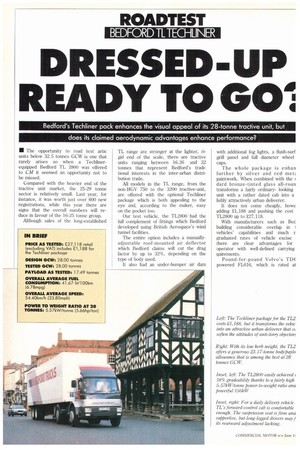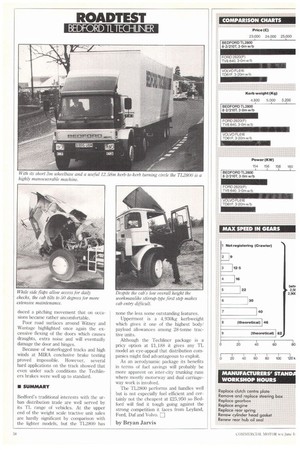DR SS READY TO GOI
Page 54

Page 56

Page 57

Page 58

If you've noticed an error in this article please click here to report it so we can fix it.
Bedford's Techliner pack enhances the visual appeal of its 28-tonne tractive unit, but does its claimed aerodynamic advantages enhance performance?
• The opportunity to road test artic units below 32.5 tonnes GCW is one that rarely arises so when a Techlinerequipped Bedford TL 2800 was offered to CM it seemed an opportunity not to be missed.
Compared with the heavier end of the tractive unit market, the 25-29 tonne sector is relatively small. Last year, for instance, it was worth just over 600 new registrations, while this year there are signs that the overall numbers will reduce in favour of the 16-25 tonne group.
Although sales of the long-established TL range are stronger at the lighter, rigid end of the scale, there are tractive units ranging between 16.26 and 32 tonnes that represent Bedford's traditional interests in the inter-urban distribution trade.
All models in the TL range, from the non-HGV 750 to the 3200 tractive-unit, are offered with the optional Techliner package which is both appealing to the eye and, according to the maker, easy on the pocket too.
Our test vehicle, the TL2800 had the full complement of fittings which Bedford developed using British Aerospace's wind tunnel facilities.
The entire option includes a manuallyadjustable roof-mounted air deflector which Bedford claims will cut the drag factor by up to 32%, depending on the type of body used.
It also had an under-bumper air dam with additional fog lights, a flush-surf grill panel and full diameter wheel caps.
The whole package is enhan further by silver and red met. paintwork. When combined with the dard bronze-tinted glass all-roun transforms a fairly ordinarylooking unit with a rather dated cab into a lishly attractively urban deliverer.
It does not come cheaply, howe adding £1,188 and pushing the cost TL2800 up to £27,118.
With manufacturers such as Bed building considerable overlap in 1 vehicles' capabilities and much n graduated rates of vehicle excise • there are clear advantages for operator with well-defined carrying quirements.
Pound-for-pound Volvo's TD6 powered 1.1616, which is rated at
tonnes GCW only, must look the be value at the weight, but for an artic ui that can be plated at either 28 or ; tonnes Bedford's TL model certainly d serves consideration.
At 4,830kg the TL2800/3200's ke weight is 140kg lighter than the FL6 and is respectively 335, 550 and 8101 below comparable Ford, Leyland and 11 models which between them last year IL about 70% of the 25-29 tonne truck ma ket.
• SPECIFICATION
Except for its lightest 1630 model, Be ford fit the renowned 8.2-litre turb charged Blue series engine to all the 1 tractive units.
The 8.2/210T produces 156kW 2,400rpm to provide a more than ad quate 5. 57kW/tonne power-to-weigl ratio at 28 tonnes gross.
Its maximum torque of 689Nrn 1,600rpm is certainly sufficient to make a fairly vigorous performer at that weigh In practice, says Bedford, it finds favoi among parcel carriers where its mo typical running weight is several tonn( below its plated limit.
At 24 tonnes GCW the TL uses as sta dard a six-speed ZF 56-65 synchromet gearbox and Bedford's own heavy-dui hypoid rear axle with a 4.38:1 final drive.
At 28 (and 32) tonnes a Fuller RT 66( nine-speed with direct top gear specified together with the Rockw( R170 hypoid rear axle and a 4.88:1 di ferential.
On 11R 225 radials, this driveline pn duces a maximum top geared speed 981on/h which with governor run-out ii creases by about 8%.
Apart from a few minor differences : gear ratios it is a near-identical drivelir to the T1v13250 tested around our Scottis route at the old speed limit four and a ha years ago (CM, December 12, 1981 Here it returned a very creditabl 38.81it1100km (7.27mpg) at a 61.5kmi (38.2mph).
II PERFORMANCE
Being more of a typical inter-city distribt tion vehicle, we decided against subjec ing the TL28 00 to our three-da operational trial. Instead we opted for th 338km one-day journey into Wales with ii
m of M4 motorway and 253krn A-road ion.
'wo years ago, and for much the same pans, CM tested a Volvo F616 at 24 les GVW around the Welsh route 1, 11 August, 1984). However, direct iparisons are impossible because the 6 had a single-axled flat bed semier while the TL2800 pulled a tandem
d boxvan. This is a similar specificato our own 32.5-tonne GVW Crane ehauf test trailer.
lespite it now being superseded by a -e powerful model, the F616's overall 'Its helps to bring the IL2800's perlance into a clearer perspective.
aden to its 28-tonne gross limit, the hliner managed only 41.671kt/100km 'mpg) at an overall average speed of lkinl (33.8mph).
Then compared with the Volvo's 29.1 00Iun (9.7mpg) at 57.71cm/h (35.8mph) TL's performance looks barely middbut several factors have to be borne mid.
lespite its Techliner trappings the four re high boxyan's extra axle plus the tional four tonnes in gross weight, luced much more rolling resistance. dictably the price of overcoming it is eased fuel consumption and slightly Ter journey times.
he TL2800 managed to maintain a ifortable near-maximum cruising speed he level stretches of the M4 in spite alustery headwinds and pulled down on the few long banks before the ern Bridge.
shrugged off any handicap to clear the unouth hill in fifth gear several inds quicker than the F616 but had to grace on the short but severe 16.6% i 6) climb south of Wintage.
lANDLING a very tidy 12.58m kerb-to-kerb ing circle and light steering one of the great strengths is its manoeuvrabil
ntering the tight 900 turn out of Ledes main street called for absolute cau
but, whether negotiating narrow ets or congested depots, thanks to its id peripheral views and easy handling e is no real problem.
his is helped all the more by the en:'s sharp acceleration and lightly ssed clutch pedal, although without a brake engaging gears became a fussy on occasions. It was not helped by an irregular engine tickover.
ver fairly smooth main roads, the 800's conventional leafspning suspenhelped by an anti-roll bar at the front an essentially level and stable ride only a minimal amount of roll.
owever on less well maintained roads Techliner's short 3m wheelbase pro duced a pitching movement that on occasions became rather uncomfortable.
Poor road surfaces around Witney and Wantage highlighted once again the excessive flexing of the doors which causes draughts, extra noise and will eventually damage the door and hinges.
Because of waterlogged tracks and high winds at MIRA conclusive brake testing proved impossible. However, several hard applications on the track showed that even under such conditions the Techliners brakes were well up to standard.
• SUMMARY Bedford's traditional interests with the urban distribution trade are well served by its TL range of vehicles. At the upper end of the weight scale tractive unit sales are hardly significant by comparison with the lighter models, but the TI.2800 has none the less some outstanding features.
Uppermost is a 4,930kg kerbweight which gives it one of the highest body/ payload allowances among 28-tonne tractive units.
Although the Techliner package is a pricy option at £1,188 it gives any TL model an eye-appeal that distribution companies might find advantageous to exploit.
As an aerodynamic package its benefits in terms of fuel savings will probably be more apparent on inter-city trunking runs where mostly motorway and dual carriageway work is involved.
The TL2800 performs and handles well but is not especially fuel efficient and certainly not the cheapest at 225,950 so Bedford will find it tough going against the strong competition it faces from Leyland, Ford, Daf and Volvo. El by Bryan Jarvis




























































